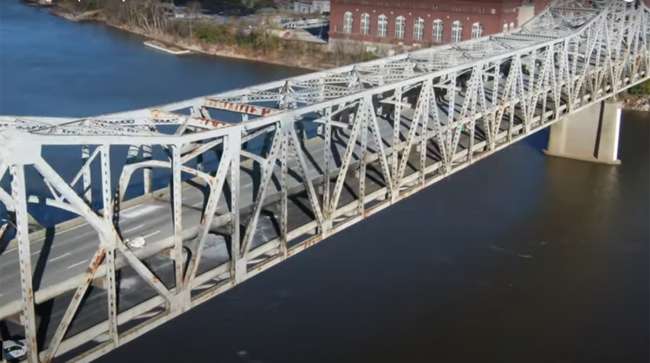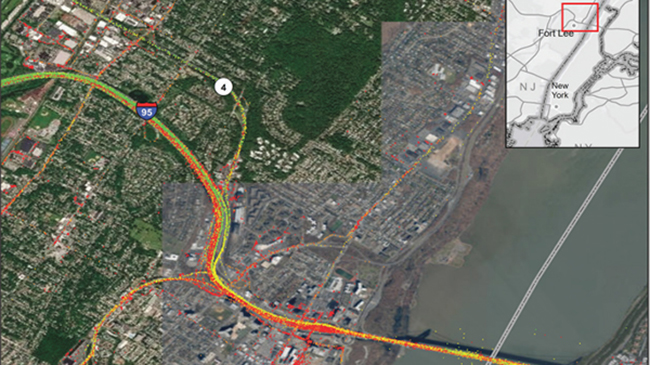Senior Reporter
Top Bottlenecks Less Congested Last Year, but Infrastructure Needs Persist, ATRI Finds

[Stay on top of transportation news: Get TTNews in your inbox.]
Trucks moved more swiftly last year through sections of road that historically are choked with congestion, as the coronavirus pandemic kept vehicles off the road and freed up highways for easier movement of freight, the American Transportation Research Institute said.
“In almost all places, congestion got better,” ATRI President Rebecca Brewster told Transport Topics. “In terms of just how painful was the congestion for the industry, 2020 was a better year in terms of the bottlenecks.”
That said, the group noted that traffic still slowed trucks down last year, and road conditions remain a challenge for the nation’s truckers.
The ATRI 2021 Top Truck Bottlenecks List found that peak truck speeds across the top 100 worst sections improved 34% in 2020 compared with 2019, as car drivers stayed home during the pandemic, the group said in its Feb. 24 report.
However, the nation’s worst chokepoint didn’t change; for the third consecutive year Interstate 95 and New Jersey State Route 4’s intersection in Fort Lee, N.J., is the country’s most congested stretch of highway. But the location’s average peak traffic speed rose 39.4% from 2019 to 31.3 mph.
ONE YEAR AGO: See last year's Top 100 bottleneck ranking
Moving to second last year from eighth in 2019 is the I-71/I-75 interchange in Cincinnati, near the Ohio River and the city’s professional football and baseball stadiums. The highway leads to the heavily traveled Brent Spence Bridge, which connects Northern Kentucky to Cincinnati. The bridge was shut down in November 2020 because of a truck fire that caused extensive damage. Beginning March 1 and continuing through Nov. 15 traffic will be reduced while crews continue repairs and repaint the 58-year-old structure.
Two locations in suburban Atlanta ranked third and fourth. I-285/I-85 North in DeKalb County, known as “Spaghetti Junction,” took third, even as its average peak speed rose 53.5% to 34.4 mph. On Atlanta’s east side in Fulton County, I-20/I-285 West ranked fourth. The area is home to numerous trucking companies; UPS Inc. opened a distribution center nearby in 2018. The average speed across the stretch rose 12.6% to 40.9 mph.
Houston’s I-45/I-69/US-59, down one spot from last year to fifth, is the subject of a $7.5 billion reroute and reconstruction plan for I-45 being finalized by the Texas Department of Transportation. The controversial project, opposed by many community groups, would move and widen much of the highway.

Congestion at the I-95, S.R. 4 interchange in Fort Lee, N.J., via TruckingResearch.org
Chicago’s I-290/I-90/94 claimed sixth place for the second consecutive year. The highway, known as the Jane Byrne Interchange after the former Chicago mayor, is in the midst of an $800 million upgrade set for completion in 2022. Peak speeds increased 57.6% to 28.8 mph in 2020.
While states such as Texas and Illinois rebuild their own roads, the Biden administration and leaders in Congress and industry are discussing the prospects of a multitrillion-dollar bill focusing on revamping America’s transportation infrastructure.
“For years, ATA has been sounding the alarm about how the condition of our highways is contributing to congestion, which slows down commerce, contributes to pollution and reduces safety,” ATA President Chris Spear said. “ATRI’s bottleneck report highlights where our most critical issues are, and should be a guide for policymakers at the state and federal level.”
Soaring from 32nd to seventh is Chattanooga’s I-75/I-24 intersection, a stretch of road undergoing a $132.6 million upgrade that Tennessee’s DOT aims to complete by the end of summer. Because of the construction work, the average peak speed here declined 1.9% year-over-year to 49.3 mph.
ATRI 2021 Top Truck Bottlenecks by Transport Topics
More info at truckingresearch.org
Jumping to eighth on the list was I-64/I-55 at I-44 in St. Louis, a stretch near downtown along the Mississippi River and the city’s baseball stadium. Construction delays contributed to its placement on the list, but lighter volume lifted peak traffic speed 10.3% to 47.3 mph.
The I-95/I-287 interchange at Rye, N.Y., ranked ninth, a stretch in the midst of a $135 million rebuilding program set for completion this year. Again, even with construction, peak speeds improved by 12% to 47.5 mph.
Tenth on the ATRI list was I-10/I-15 in San Bernardino, Calif., east of Los Angeles. Near Ontario International Airport, the intersection saw a surge in freight volume in 2020 fueled largely by e-commerce. Cargo shipments at the airport were up 15.6% year-over-year in January. Plus, FedEx Corp. in December completed a $100 million expansion of its capacity there.
With last year’s congestion declines viewed as an aberration caused by the pandemic, ATRI’s Brewster said improvements to the nation’s roads must be made to ensure longer-term declines in congestion. “These are a lot of the same locations, year after year, even with car drivers staying home,” she said.
“While everyone else sheltered in place in 2020, trucks keep rolling, delivering essential goods to communities,” added CRST The Transportation Solution CEO Hugh Ekberg in the ATRI news release on the report.
The full report, including details about the top 100 locations, is available at truckingresearch.org.
Want more news? Listen to today's daily briefing below or go here for more info:




